12/1/2023
Building The Plant Company
Chris Beytes
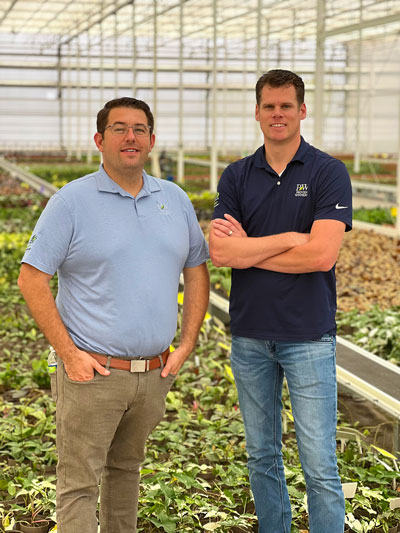
This is the story of how brothers-in-law Jason vanWingerden* and Frank Paul dreamed up and built The Plant Company, how and why they hooked up with Proven Winners, and what they’ve learned in the process.
The Plant Company story begins at Green Circle Growers, operated by Jason’s family, including his dad, the patriarch, John Van Wingerden*. Jason, 39, had been working in the family business for 15 years, involved with purchasing, marketing and finance. Jason’s brother-in-law Frank, 38 (they married sisters), was born into a horticulture family in the Netherlands. He’d been head orchid grower at Green Circle for about a dozen years.
Pictured: The partners say they are polar opposites. Jason (left) is the visionary who paints the picture you can believe in, while Frank is the integrator who makes that vision a reality.
As a member of a thriving family business, Jason watched as his three brothers and brother-in-law Scott Giesbrecht talked with their older children about coming into the business. Jason, whose kids are much younger, wanted it for them, too. But he wondered if the business could support so many of the third generation. Or perhaps it was time to build something of his own to pass down.
“Do you keep going down the same path?” he wondered. “Or do you say, it’s early enough to start something new?”
Jason knew his options. Growing up in the industry and traveling extensively, Jason had recognized a need for what he calls “European-style” foliage production: tissue culture young plants (whenever possible) produced in facilities that promote high quality and high uniformity every week of the year. He knew Dutch foliage growers and their technology, and he’d been watching the growing trend in houseplants here and abroad. And he had the moral support of an experienced and influential retailer and close family friend, Angelo Petitti, founder of Petitti’s, a nine-store IGC chain in the Cleveland area.
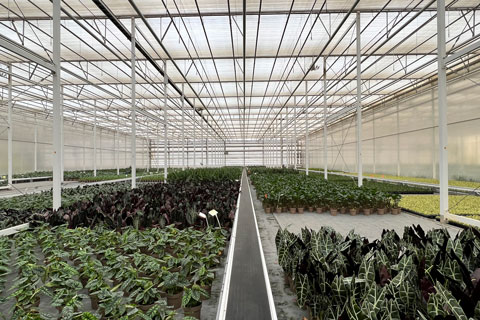 Pictured: Everything about the greenhouse, from the column color (white) to the choice of floor system (Erfgoed), was designed to minimize summer heat.
Pictured: Everything about the greenhouse, from the column color (white) to the choice of floor system (Erfgoed), was designed to minimize summer heat.
Recalls Jason, “Angelo said, ‘The independents need someone who can produce good, clean, quality foliage and focus on [IGCs].’ So we said, ‘Hey, maybe this is the right time to do it.’”
The “we” in the new venture was his brother Wesley. But Jason decided to open the offer to his brother-in-law, too.
“Alison and I had Frank and Emily over and we told them, ‘Hey, you know, we’ve decided to start our own business. This is what we’re thinking. Would you want to come along?’”
It didn’t take much convincing. Pretty quickly the three were partners. (However, shortly after starting the business, Wes decided to leave the venture and return home due to an ongoing family health situation.)
And what about the patriarch of the family, John? How did he take the news of the boys’ plans?
“It took him a bit,” Jason answered. “But he said, ‘You know what? I did the same thing with my dad, so it’s difficult for me to take a different approach and say, no, you can’t, or no, you shouldn’t.’”
Finding Stuarts Draft
The first order of business: a location. They wanted to be south of Green Circle’s base—Oberlin, Ohio—but not so far south they’d have to deal with summertime heat dormancy of their foliage. They also wanted to remain within driving distance of their families. And they wanted to be close to the market.
Drawing a circle on a map, they found themselves considering Virginia’s Shenandoah Valley, specifically the town of Stuarts Draft, at about 1,500 ft. in elevation, with an average daily temperature in the low 70s F, and located just four miles from two major interstate highways.
Said Jason, “It had all the things we needed … the biggest thing was climate.” Including plenty of sunlight and sunny days. “We didn’t realize how much overcast there was from the lake (Erie) until you move away from it. You’re like, wow, it’s significant!”
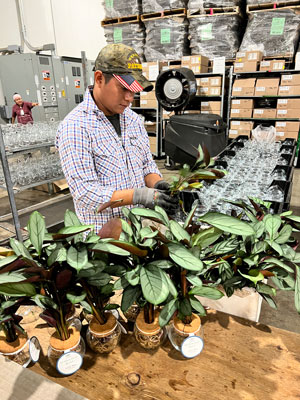 Pictured: A worker assembling leafjoy’s hydroponic H2O product line.
Pictured: A worker assembling leafjoy’s hydroponic H2O product line.
By early 2020, the team had decided on a crop and a location. They’d inspected half a dozen properties, and were meeting with growers and structure manufacturers, researching suitable greenhouses.
Then the pandemic struck.
Thankfully, they had their financing lined up through AgCredit, so that was set. But would there even be an industry to serve?
“At the beginning [of the pandemic], everyone thought the industry was going to collapse because for the first few months, who knew?” recalled Jason of those uncertain days. “And then after that, it was a huge boost for everyone.” Including houseplant growers and sellers—although as Frank said, “We saw that trend well before COVID. If anything, COVID supercharged it, but we really see [houseplants] as a lifestyle change.”
Despite (or maybe because of) the many labor, travel and logistical challenges caused by the pandemic, the guys took the extra time to thoroughly research every element of the project.
As Jason said, “You know, after 20 years, is three or four months going to matter? No. That three or four months could help us not make a poor decision.”
Clearing and leveling of their Stuarts Draft property took place in late 2020, with the boys doing some of the work, such as tree-clearing, themselves. By January 2021, they were erecting their first 5 acres of greenhouse. By May 15, they were planting. And by July, “The Plant Company,” as the guys dubbed their business, began shipping plants.
The greenhouses
What sort of greenhouse is needed for European-style foliage production outside of Europe? Head grower Frank explained that the big challenge is summer heat: “Keeping the plants cool without having to pay for cooling because you can’t afford to cool indoor houseplants.”
They do that in several ways. First, with a tall greenhouse—23 feet (7 meters) to the gutters—which they learned from the greenhouse vegetable industry. The structure, which combines Prospiant columns and sidewalls with a Boal Group roof system, gives the heat plenty of space to rise, keeping the lowest air strata around the plants cool. The columns are coated white to reflect heat. Erfgoed flood floors let them pump cool well water in the summer to keep the root zones cool. Lastly, high-pressure fog provides an additional layer of summertime cooling.
They started with 5 acres, and are currently prepping for another four, giving them 9 acres of greenhouses as of May 2024. The first 1.5 acres of production barn seemed cavernous, but they’re expanding that to 3.5 acres to keep up with their rapid growth.
The visitors
With dozens of Van Wingerden relations operating greenhouses up and down the East Coast, plus relationships with numerous non-family operations, it would seem that contract growing would be an easy way to enter the market. And Jason admitted that yes, they started out with that thought in mind. However, they didn’t want to rely on others to sell their product for them.
“You want to own it yourself and do it yourself,” he said, but he admits, “We were probably a little bit young and naïve thinking, ‘If you build it, they will come.’”
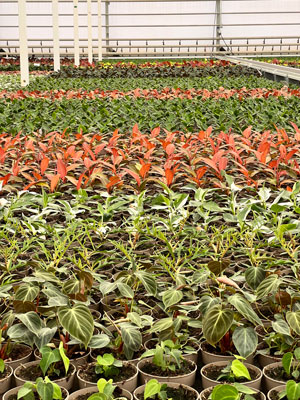 Pictured: “We didn’t want to be the cheapest guy out there. We wanted to present the best value for the end consumer.”—Jason vanWingerden
Pictured: “We didn’t want to be the cheapest guy out there. We wanted to present the best value for the end consumer.”—Jason vanWingerden
They needed customers who would pay a reasonable price for a high-quality product. To that end, they brought in director of sales Chris Ricci, another Green Circle veteran, to pound the pavement. Sales began in July and the initial response was favorable. They were off to a good start.
And then three guys in Proven Winners shirts showed up for a tour.
It was Dave Konsoer, Kevin Hurd and John Gaydos. Dave, VP of Sales for the brand, had heard rumors of the guys’ venture and wanted to see for himself. He brought along Kevin (VP of Product Development) and John (Director of Product Development). Jason said they all hung out for the day, talking about the philosophy of The Plant Company—producing a high-end indoor plant that would give the consumer the best chance of succeeding.
“It took them about an hour,” said Jason. “And then after an hour, they were like, ‘We’ve got to figure out a way to get you guys in [to the Proven Winners network].’ They had been looking for someone to partner with. And no one ever really fit what they were looking for.”
But Frank said the visit wasn’t happenstance. “They came with an agenda that we weren’t aware of at the time.”
“Yeah, we had no clue,” agreed Jason. “But it became clear pretty quickly. And then Tom [Smith] and Henry [Huntington, Proven Winners’ founding partners] were out here, I think less than seven days later. They were excited about the fact that it was a new company that shared their values in providing a better plant for the consumer, but that wasn’t already tied down.
“They first wanted to hear a little bit more about us,” he continued. “I’d known those guys for quite a few years. They got to meet Frank, spend some time with him. And then, yeah, we just kind of sat down, talked through it. And we both said this sounds like it’d be a really good partnership because we love growing plants. They love marketing plants.”
The two parties reached an agreement in October and “leafjoy” houseplants from Proven Winners officially launched in January. Since then, they’ve picked up some important young plant accounts, including Bell Nursery, which gets their varieties into Home Depot. And they’ve added a foliage grower, Fessler Nursery in Oregon, to the network.
Entering into an exclusive partnership so soon after seeking independence seems counterintuitive. Any hesitation? Any second thoughts?
“No,” Jason answered quickly. “And that’s because of the way Proven Winners actually runs. They let their licensees run their businesses. They’re really just the marketing side of it. We still do all the sales. We still do all the variety selections and development and R&D. They let us maintain our autonomy. And they just market the heck out of the brand for us.”
Of course, they did their homework, interviewing the other Proven Winners partners, Walters Gardens and Spring Meadow Nursery.
“Jeremy [Deppe] at Spring Meadows has been awesome. He said, ‘These guys are really good to work with. And they let you still run your business. But the best thing is it’s an unbelievable brand that most consumers recognize. Why wouldn’t you want to partner with them?’”
Close friend Angelo Petitti put it more bluntly when the guys asked his opinion.
“Angelo was like, ‘If you guys don’t do it, I’m going to come down and hit you upside the head,’ recalled Jason with a smile. “He sees the value of branding and that the consumers actually recognize it. And, of course, he would know because he deals with them every single day.”
Jason said some in the family thought the pair were giving up control. But Jason argued to the contrary.
“We viewed it more as we’re taking something that we’re not good at and giving it to someone that is so much better than us. In their first year, they’ll do more than what we could do in 10 years.”
What they’ve learned
It’s been just over two years since inking the deal with Proven Winners, two whirlwind years in which The Plant Company has doubled in size (and is doubling again), and has seen revenue growth that Jason conservatively said “has gone a lot better than what we thought. I don’t want to share it because I don’t want to come across as anything other than that we are very humbled with how well the business has been able to grow, and thankful to our retail customers who have trusted us in this new endeavor. We feel very blessed with the position we’re in today.”
They will admit to some minor issues with learning the branded plant game—Jason mentioned some off-brand shirt colors and a leather PW logo.
“We’re still learning what it takes to do a brand like this. I mean, it’s a consumer-facing brand to where on the back of our tags is a number to the call center … Yeah, learning how to function within their marketing organization, that definitely took a little bit to figure out.”
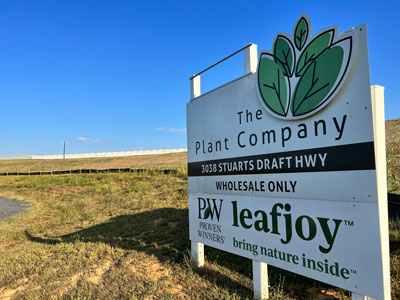 Pictured: “We wanted to come up with a name from which we could diversify into any different business,” Frank explained of the company’s moniker. “We wanted to start with foliage, but as we built our customer base, what if we added some kind of flower item?” They had a whole whiteboard with ideas. They crossed some off, added some more, but nothing stuck. “What are we doing? We’re growing plants. Could it be as simple as The Plant Company?”
Pictured: “We wanted to come up with a name from which we could diversify into any different business,” Frank explained of the company’s moniker. “We wanted to start with foliage, but as we built our customer base, what if we added some kind of flower item?” They had a whole whiteboard with ideas. They crossed some off, added some more, but nothing stuck. “What are we doing? We’re growing plants. Could it be as simple as The Plant Company?”
“And theplantcompany.com was available,” added Jason.
What’s been the biggest challenge of starting a new business? Realizing how much was already in place and taken for granted back at Green Circle.
“We’re still finding stuff where we’re like, ‘Wait, we don’t have a process for that?’” said Jason. “You were so used to it at your last place and now you’re literally having to train people how to plant a plant on the line the first week. You don’t think about that when you start your own business from scratch. It means you have to train every employee to do every task.”
“Starting from scratch, it’s both a blessing and a curse,” added Frank. “There are no sacred cows, no set way of doing things. At the same time, you don’t have a team that has a tenure of five-plus years that is used to the industry, is used to the way of doing things. So, yeah, from that perspective, you’re teaching everyone everything. And that takes time.”
What else has Jason and Frank learned from their experiences both at Green Circle and The Plant Company?
“Focus on the things that drive you the craziest,” answered Jason. “I remember we sat down in our living room talking, before this was even built, and we said, ‘What would vendors do to us that would always drive us crazy? Get rid of those. Don’t do them.’ Like nickel-and-dime stuff. ‘Oh, you’ve got to pay an extra penny for a leaf shine.’ Why? It’s a penny, who cares? Just do it, include it. If you’re trying to present a retail-ready product, do it. Why try to charge someone more for a decision that you’ve made?”
And Frank’s best advice?
“We always say a bad decision is better than no decision. So, make a decision and move on. But also, be willing to be wrong. Acknowledge it, change it and again, move on.
“We’ve got a lot going on,” he continued. “We’re trying to build a great company and so speed is essential. So, yeah, look at the facts in front of you, make a decision, move on. If it’s wrong, change it along the way. But don’t slow down.” GT
*The Van Wingerdens spell their last name in various ways; we try to spell it the way each prefers.